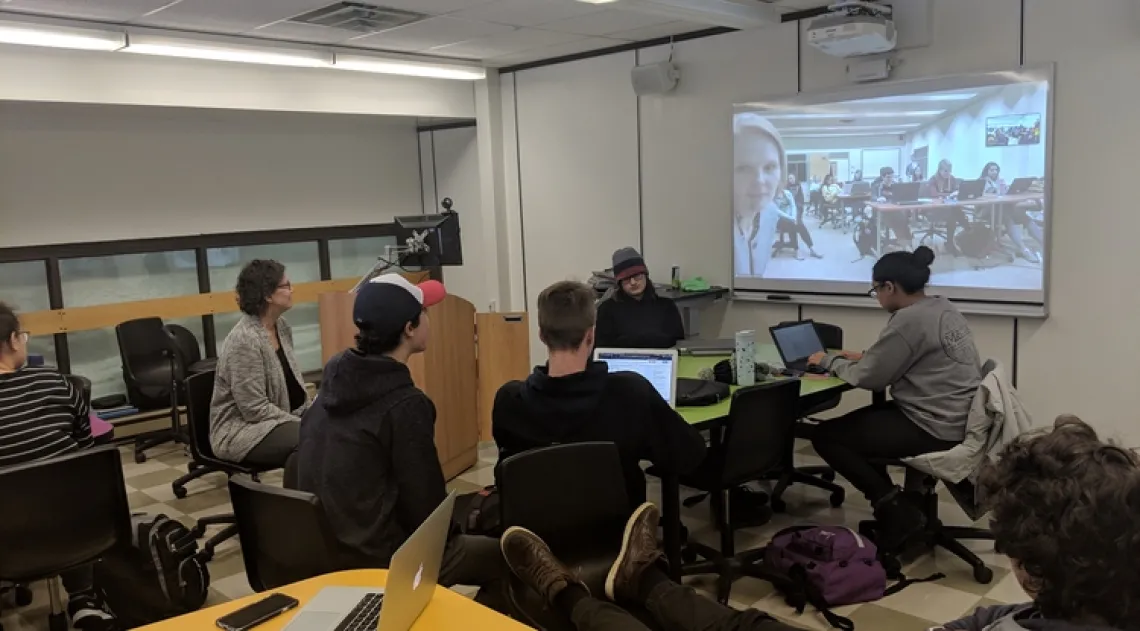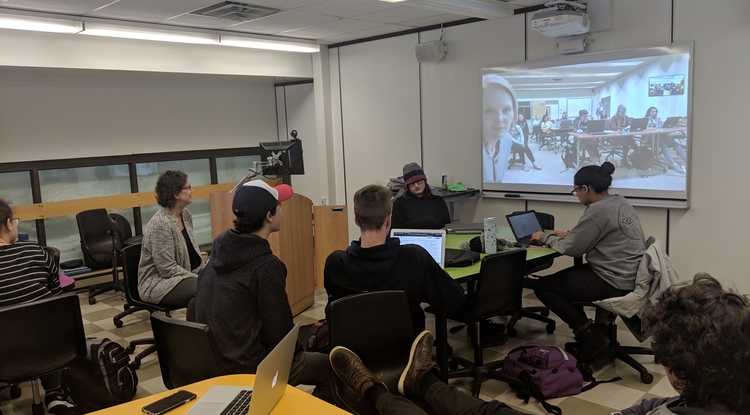Mapping the Borderlands, Where Languages and Cultures Coexist

Any examination of life near international borders yields the expected divisions between countries and languages, but a deeper dive also uncovers evidence of the subtle differences – and similarities – that exist in areas of cultural overlap.
University of Arizona students studying French and Russian, together with their peers in two other counties, are taking a closer look at borderland regions thanks to a new research and teaching collaboration that is supported by a grant from the UA Center for Digital Humanities.
The students are being guided through an interdisciplinary study of three borderlands regions, Québec-New England, Mexico-Southern Arizona, and Russia-Northern Kazakhstan, by UA faculty Liudmila Klimanova and Emily Hellmichand their colleagues at the Cégep de Sept-Îles in Québec and Kostanay State University in Kazakhstan.
Mapping the borderlands
“They’re very particular places, borderlands, characterized by a lot of paradoxes,” says Hellmich, an assistant professor of French at the UA. “We talk a lot about borders today. At the same time globalization is making us more connected, there’s more building of borders, both real and ideological. We wanted to think about what our students are living and how these conversations could enhance the learning of language and culture.”
globalization is making us more connected, there’s more building of borders, both real and ideological. We wanted to think about what our students are living and how these conversations could enhance the learning of language and culture.”
“When we have cultures rubbing up against each other, that process creates new forms of thinking and being. It creates new types of cultures,” says Klimanova, an assistant professor of Russian and Slavic Studies. “We talk about languages, and we see interesting forms of bilingualism. There’s no right or wrong language. They coexist because of the proximity to one another at the border. That exists at the cultural level, too.”
The UA students and their peers all contributed to a digital mapping platform called "Mapping the Borderlands." They uploaded photos, videos and 360-degree photos that showcased particular elements of cultural exchange in the border regions. The resulting collaborative map features geospatially located data documenting the lives of borderland youth, with categories cross-tagged to enable critical analysis.
“This idea of mapping comes into play because we can see the artifacts of bilingualism and put them on the map to show how that diversity plays out in a community," Klimanova says. "Maps let us see relationships between visible entities, like borders, and invisible entities, like opinions, language affiliations, political stances and more,” Klimanova says.
“By zooming in on a map and seeing what’s there, students are able to visually engage with a community at a distance. This is an absolutely fantastic learning tool. Students can virtually visit these communities and see through 360-degree imaging what it’s like in that part of the world.”
Learning the language, and more
Though they’re in different departments at the UA, Klimanova and Hellmich have research interests that overlap. Both ause digital technology as a part of language and culture instruction, and both are interested in borderland regions and the coexistence of different languages and cultures in the same location.
They designed the project to connect students in their classes with peers in other borderland regions, so students could explore the topic of borderlands together while working on language skills. Klimanova’s students were some of the first foreigners to ever interact with their Kazakhstani peers.
“Being close to the border here in Tucson is a lot different than the experience the students in Kazakhstan have in being next to the border with Russia," says Evan Rowe, a Russian major. "For people here in the United States, the border with Mexico is a huge topic, but when I talked to some of the students there, they didn’t feel like they lived next to a border. It definitely helped understand the similarities and differences between the two cultures.”
The exchange also served to highlight the linguistic borders that exist between the students and the permeable nature of such borders.
“People face language barriers, and for me, it’s English to Russian. I studied last summer in Moscow and I’d struggled to get over that border, but using it more and more in this project helped me overcome that,” Rowe says. “It was a different way of utilizing our conversational Russian. Instead of speaking with classmates, where we’re all generally on the same level, it was really nice to talk to people whose native language was Russian. The technology gave us the ability to do that.”
In connecting with peers in Canada, a country that borders the United States, Hellmich’s students were able to reflect on more commonalities. But they still came away with new perspectives on the subtle ways cultural borders exist alongside physical ones.
“We were talking about the types of borders that are here in Tucson, where a lot of people are bilingual in English and Spanish, and people in Québec, where a lot of people are bilingual in French and English,” says Leticia Marie Harris, who is pursuing a double major in French and psychology at the UA. “By sharing our language barriers between the two locations, we were able to find similarities.”
Through the course of the class, both Klimanova and Hellmich say their students began to look at borders in different ways – national, linguistic, cultural, personal – all of which have the potential for additional exploration.
“We want this digital humanities pilot project to become more public and more global and serve as an intercultural exchange. We’ll look at as many borderlands as we can capture,” Klimanova says. “It’s a critical issue in the community and a way to see your community through the eyes of another perspective. That’s the kind of language education we want. The conversations have a purpose – to share ideas and explore concepts.”
A version of this article originally appeared on the College of Humanities website: https://humanities.arizona.edu/news/mapping-borderlands

